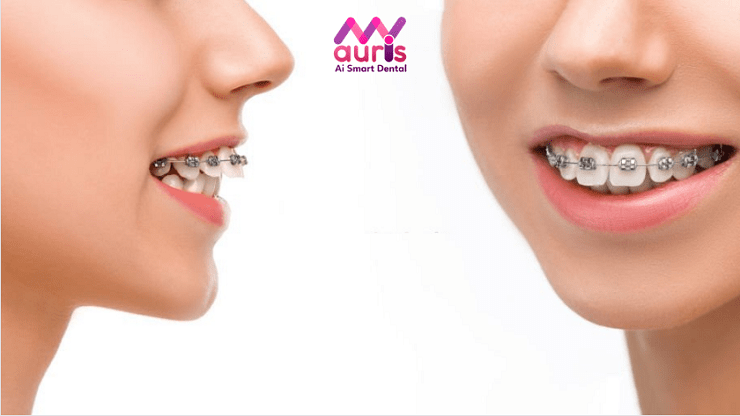Deep bite braces are a solution to improve oral health. However, this case is very rare, but this type of bite still occurs and not only causes serious harm to the patient such as jaw misalignment, difficulty eating, and gingivitis. So what are the signs of a deep bite? And what are the restoration methods to improve the standard bite? Join My Auris dentistry to find out details through the article below compiled by experts.
What is a deep bite? Signs of recognition
A deep bite is a misaligned bite that causes imbalance between the upper and lower jaw. Specifically, the lower jaw is located deep inside the upper jaw. This condition occurs when the lower teeth grow inward or because the upper jaw bone is too large. What’s more, this condition can occur in children and adults.
Signs of deep bite with some characteristics such as:
- The lower teeth cannot touch the upper teeth. In severe cases, the lower teeth grow out and touch the gums of the upper jaw.
- The upper and lower jaws are not correlated with each other. The upper jaw often obscures the lower jaw. When the mouth muscles relax, the lower jaw cannot be seen, the upper jaw protrudes slightly.
- There is no correlation between forehead, nose and chin.

Harmful effects of having such a deep bite
A deep bite not only affects the patient’s oral health as well as the mental health. Specifically:
- Effects on aesthetics: Makes the face unbalanced and lacks harmony. The chin will look shorter, giving you the feeling of having a protruding or exposed gums.
- Affects chewing function: Deep bite makes it difficult for the upper two to touch each other. Makes chewing more difficult and slower. In addition, chewing and crushing food is not guaranteed.
- Suffering from dental diseases: When the contact of two jaws is misaligned, mainly the inner gum surface of the jaw can easily cause gum damage. This condition can last up to theDental diseases such as: gingivitis, gingivitis, periodontitis.
- The upper teeth are likely to wear out: With a deep bite, the enamel of the upper teeth will be worn away. From there, it causes exposed dentin and sharp pain when chewing.
- Temporomandibular arthritis: Jaw misalignment can lead to temporomandibular arthritis. If not treated promptly, it will not affect health much.
For mild cases of deep bite, about 4mm to 5mm. In contrast, heavy bites are about 6mm or more. Normally, the upper jaw has a normal size but the lower jaw is small, leading to an abnormally large upper jaw ratio.
At this point, the doctor will move the upper jaw outward to create a balanced mouth without affecting the upper jaw. Using braces is the optimal solution for complete treatment. When you go through the orthodontic process, the upper and lower jaw will become normal and bite properly. Thanks to that, chewing function and aesthetic smile are restored to the patient.

Braces methods to correct bite deep bite
Deep bite braces are an effective solution to overcome this situation. There are many different orthodontic methods on the market. Depending on your needs and economic conditions, you can choose the appropriate method for yourself. Including popular braces methods such as:
Metal braces
Is a commonly used braces method. Applicable to cases of malocclusion including deep bite, considered a difficult restoration in orthodontics. The material of metal braces is made of stainless steel, silver or gold, depending on the user’s needs. With this method, the doctor will attach the braces to the tooth surface, they are linked by an arch wire and elastic band.
The advantage of this method is the low cost of implementation, the metal frame is of high quality and can withstand good tightening force.
Bracket braces Porcelain
Ceramic braces are a more optimal option than metal braces because of the aesthetics of braces. Braces are made of ceramic, so this type of braces is extremely safe, compatible with the oral environment and does not cause irritation to the body.
Moreover, ceramic braces match the color of the braces.Because they are real teeth, it is very difficult for the other person to recognize them during orthodontic treatment. The advantage of this method is high aesthetics and comfort when used.
lingual braces
This method is also known as lingual braces. This type of braces is designed quite similar to metal braces, but is positioned on the teeth. The brackets and wires are attached to the inside of the teeth.
Internal braces ensure aesthetics and are very difficult for people to detect when wearing braces. This technique requires high expertise, so you need to have it done at reputable dentists.
Braces without brackets
Braces without brackets is a modern braces method, also known as transparent braces. However, this method overcomes the shortcomings of traditional orthodontic methods.
Currently, there are many transparent braces methods, in which braces from the brands Invisalign, iWay,.. are well known and trusted. Furthermore, braces provide high aesthetics, suitable for customers who frequently communicate. In addition, the brace tray is easy to remove for cleaning or while eating.

How long does it take to get braces for a deep bite?
Today, with the development of dental technology, deep bite braces have become simple and extremely effective. So, how long does it take to get braces for deep bite?
Normally, in case of mild braces for deep bite, it takes 1 – 1.5 years. On the contrary, complex deep bite cases will last 2 – 3 years.
Moreover, the braces time will also depend on the orthodontic method and the doctor’s compliance with regulations. In order for the braces process to go quickly, you need to have timely examinations and proper oral hygiene.
Above is useful information about the issue of how long it takes for braces to have a deep bite. Hopefully this article will help you learn the methods. Orthodontic treatment suitable for your oral health condition. IIf you want to learn about the service, please contact My Auris dentistry directly, the doctors willLet me give you more detailed advice!
Kim Dung





